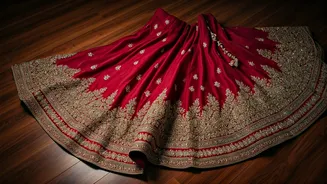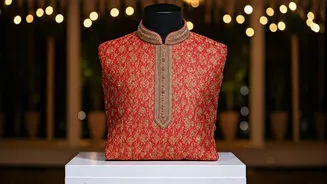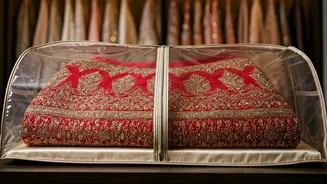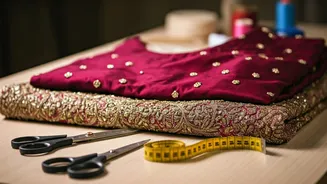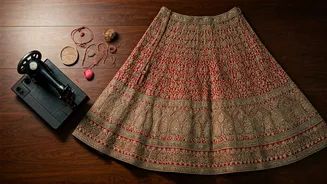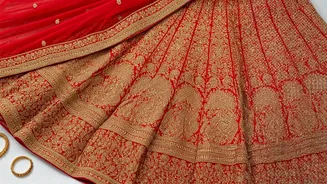Initial Preparations
Before stowing your lehenga away, thorough preparation is key to safeguarding its beauty for the long term. This process begins with a gentle yet effective
cleaning. Depending on the embellishments and fabric, consider professional dry cleaning to avoid any damage. Following cleaning, allow the lehenga to air dry completely, ensuring no moisture remains. Examine the garment closely for any loose threads or minor repairs needed, which should be addressed before storage. This proactive approach helps prevent further damage. The goal is to present a clean, repaired, and completely dry lehenga to the next stage of preservation. These steps are crucial to ensure that your lehenga stays in good condition and is ready to be worn whenever the occasion arises in the future.
Wrapping It Right
The method of wrapping your lehenga plays a significant role in its preservation. Opt for acid-free tissue paper or muslin cloth to shield the delicate fabric and embellishments from environmental harm. Start by gently folding the lehenga, ensuring that intricate embroidery or embellishments are protected and not directly folded upon themselves, which could lead to damage over time. Each section of the lehenga, including the blouse, skirt, and dupatta, should be wrapped separately. This separation prevents potential color transfer or friction between the different parts. Consider placing silica gel packets within the wrapped sections to absorb any residual moisture. These methods will provide the lehenga with the best possible protection during long-term storage, keeping it in the best possible shape for years to come.
Storage Environment Matters
The storage environment is paramount for protecting your wedding lehenga. Choose a cool, dry, and dark location, away from direct sunlight, which can cause colors to fade and fabrics to weaken. A closet dedicated to storing delicate garments is ideal. Ensure the area is well-ventilated to prevent the buildup of moisture, which could foster mold and mildew. Avoid storing the lehenga in plastic bags, as they can trap moisture. Instead, opt for breathable cotton garment bags. Regularly check the storage area for any signs of pests or changes in humidity. These small precautions will provide the proper environment to prevent damage and keep your lehenga looking good as new. The care taken in selecting a storage location will play a huge role in preserving its beauty for years to come.
Dealing with Embellishments
When storing lehengas with heavy embellishments, special care is required to prevent damage. Be sure to wrap the embellished areas carefully, perhaps using additional layers of acid-free tissue paper to add an extra layer of protection. This is particularly important for delicate items like sequins, beads, and zari work, which are prone to snagging or abrasion. Consider hanging the lehenga on a padded hanger if space allows. If not, ensure the lehenga is folded to minimize stress on the embellishments. Regularly inspect the lehenga for any loose embellishments. Address any repairs or reattachments promptly to prevent further deterioration. Taking special care of the embellishments when storing is an important step to ensure your lehenga maintains its beauty and intricacy for generations to come.
Regular Inspection Needed
Periodic inspection of your lehenga is crucial to ensure its ongoing preservation. Set reminders to check the lehenga every few months. During these inspections, carefully unfold each part of the outfit. Look for any signs of fading, discoloration, mold, or insect activity. If any issues are found, address them immediately. Gently air out the lehenga in a well-ventilated space for a few hours before re-wrapping and storing it. This practice allows for moisture release and helps maintain the garment's freshness. By making regular inspections a habit, you will prevent minor issues from becoming major problems. These regular inspections allow you to take action and ensure your lehenga will remain a treasured item for many years.


